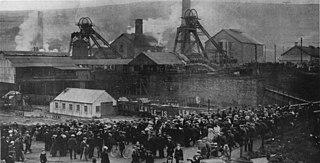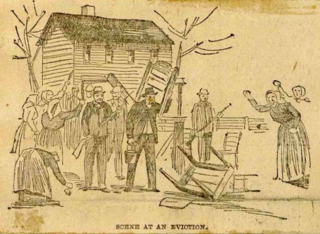
Courtney is a village of the township of Union in Washington County, Pennsylvania, United States.

Courtney is a village of the township of Union in Washington County, Pennsylvania, United States.
On April 23, 1913, a mine owned by the Monongahela River Coal company experienced an explosion, trapping 250 workers inside. Anywhere from 90 to 125 were reported to have died in the accident. [1] [2]

Clymer is a borough in Indiana County, Pennsylvania, United States. The population was 1,336 at the 2020 census. The community was named after William Bingham Clymer, grandson of George Clymer, one of the signers of the United States Declaration of Independence. William Clymer sold the land the borough is situated on to Thomas White in the 1830s. Most of Clymer's family died in a tragic sea accident in 1878, which made national news and inspired the name. It is surrounded by but separate from Cherryhill Township.

Marianna is a borough in Washington County, Pennsylvania, United States. The population was 399 at the 2020 census.
A mining accident is an accident that occurs during the process of mining minerals or metals. Thousands of miners die from mining accidents each year, especially from underground coal mining, although accidents also occur in hard rock mining. Coal mining is considered much more hazardous than hard rock mining due to flat-lying rock strata, generally incompetent rock, the presence of methane gas, and coal dust. Most of the deaths these days occur in developing countries, and rural parts of developed countries where safety measures are not practiced as fully. A mining disaster is an incident where there are five or more fatalities.
Benxihu (Honkeiko) Colliery, located in Benxi, Liaoning, China, was first mined in 1905. Originally an iron and coal mining project under joint Japanese and Chinese control, the mine came under predominantly Japanese control. In the early 1930s, Japan invaded the northeast of China, and Liaoning province became part of the Japanese-controlled puppet state of Manchukuo. During the Second Sino-Japanese War, the Japanese forced Chinese labourers—some of whom had been captured from local military organizations—to work the colliery under very poor conditions. Food was scarce and workers did not have sufficient clothing. Working conditions were harsh, and diseases such as typhoid and cholera flourished due to poor sanitation and water supplies. Typically miners worked 12-hour shifts or longer. The Japanese controllers were known to beat workers with pick handles, and the perimeter of the mine was fenced and guarded. Many describe the conditions as slave labour.

Dawson is a ghost town in Colfax County, New Mexico, United States. Dawson is located approximately 17 miles northeast of Cimarron, and was the site of two separate coal mining disasters in 1913 and 1923. In 1950, the mines were closed, and by 1954 the last residents had left and the post office closed.

The Senghenydd colliery disaster, also known as the Senghenydd explosion, occurred at the Universal Colliery in Senghenydd, near Caerphilly, Glamorgan, Wales, on 14 October 1913. The explosion, which killed 439 miners and a rescuer, is the worst mining accident in the United Kingdom. Universal Colliery, on the South Wales Coalfield, extracted steam coal, which was much in demand. Some of the region's coal seams contained high quantities of firedamp, a highly explosive gas consisting of methane and hydrogen.
The Castle Gate mine disaster occurred on March 8, 1924, in a coal mine near the town of Castle Gate, Utah, located approximately 90 miles southeast of Salt Lake City. All of the 171 men working in the mine were killed in the series of three violent explosions. One worker, the leader of the rescue crew, died from carbon monoxide inhalation while attempting to reach the victims shortly after the explosion.

The Coal Glen mine disaster was a series of explosions that occurred on May 27, 1925, at a coal mine in Coal Glen, Chatham County, North Carolina, United States. At least 53 miners died in the explosions, making it the deadliest industrial disaster in North Carolina's history. The incident also partly contributed to North Carolina's adoption of a workers' compensation law several years later.

Farmville is a community in southeastern Chatham County, North Carolina, United States, which was once called Coal Glen. The area was the site of coal mining activities from the 18th century up the mid-1950s, and was the site of the 1925 Coal Glen mine disaster.

Zasyadko Mine is a coal mining company in Ukraine's eastern city of Donetsk. Following the start of the War in Donbass in 2014 the mine became situated in rebel controlled territory.
The Naomi Mine explosion occurred on December 1, 1907, in the Naomi Mine, approximately 2 miles (3.2 km) from Fayette City, Pennsylvania. The incident resulted in the deaths of at least 35 miners and left no survivors.

The Upper Big Branch Mine disaster occurred on April 5, 2010 roughly 1,000 feet (300 m) underground in Raleigh County, West Virginia at Massey Energy's Upper Big Branch coal mine located in Montcoal. Twenty-nine out of thirty-one miners at the site were killed. The coal dust explosion occurred at 3:27 pm. The accident was the worst in the United States since 1970, when 38 miners were killed at Finley Coal Company's No. 15 and 16 mines in Hyden, Kentucky. A state funded independent investigation later found Massey Energy directly responsible for the blast.
The Benwood Mine Disaster was a coal mine explosion that occurred on Monday, April 28, 1924, at the Benwood Mine of the former Benwood Works of Wheeling Steel Corporation located in the city of Benwood in Marshall County, West Virginia. The disaster claimed the lives of 119 coal miners. There were no survivors. It is the third worst coal mining disaster in the state of West Virginia after the Monongah Mine disaster of December 6, 1907, that claimed the lives of 361 miners and the Eccles Mine Disaster of April 28, 1914, that claimed the lives of 183 miners.
The Cadeby Main Pit Disaster was a coal mining accident on 9 July 1912 which occurred at Cadeby Main Colliery in Cadeby, West Riding of Yorkshire, England, killing 91 men. Early in the morning of 9 July an explosion in the south-west part of the Cadeby Main pit killed 35 men, with three more dying later due to their injuries. Later in the same day, after a rescue party was sent below ground, another explosion occurred, killing 53 men of the rescue party.

The Morewood massacre was an armed labor-union conflict in Morewood, Pennsylvania, in Westmoreland County, west of the present-day borough Mount Pleasant in 1891.
The Banner mine disaster of April 8, 1911 near Littleton, Alabama was a coal mine explosion that killed 128 people. The event ranks among the 15 deadliest coal mine disasters in U.S. history.